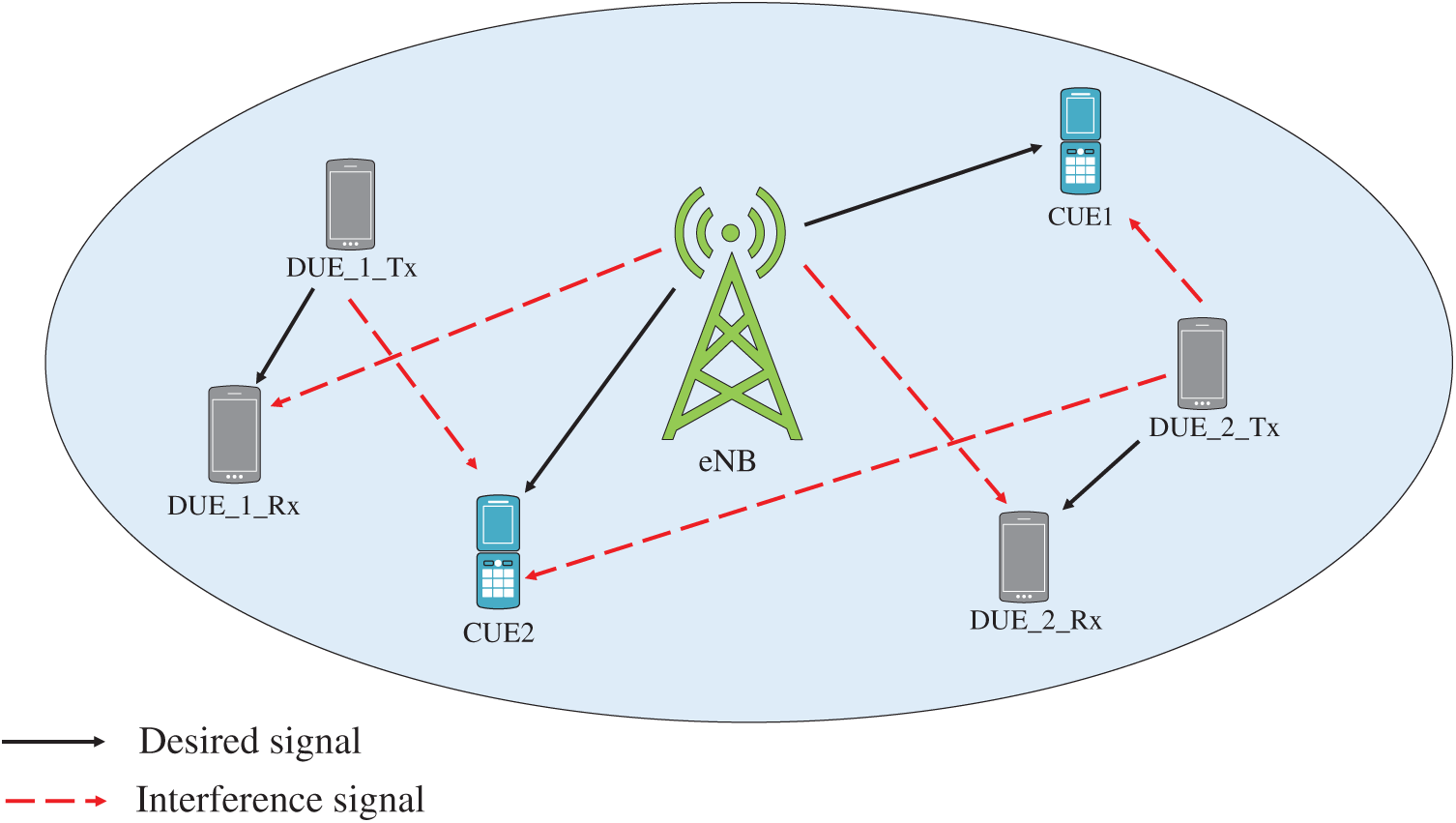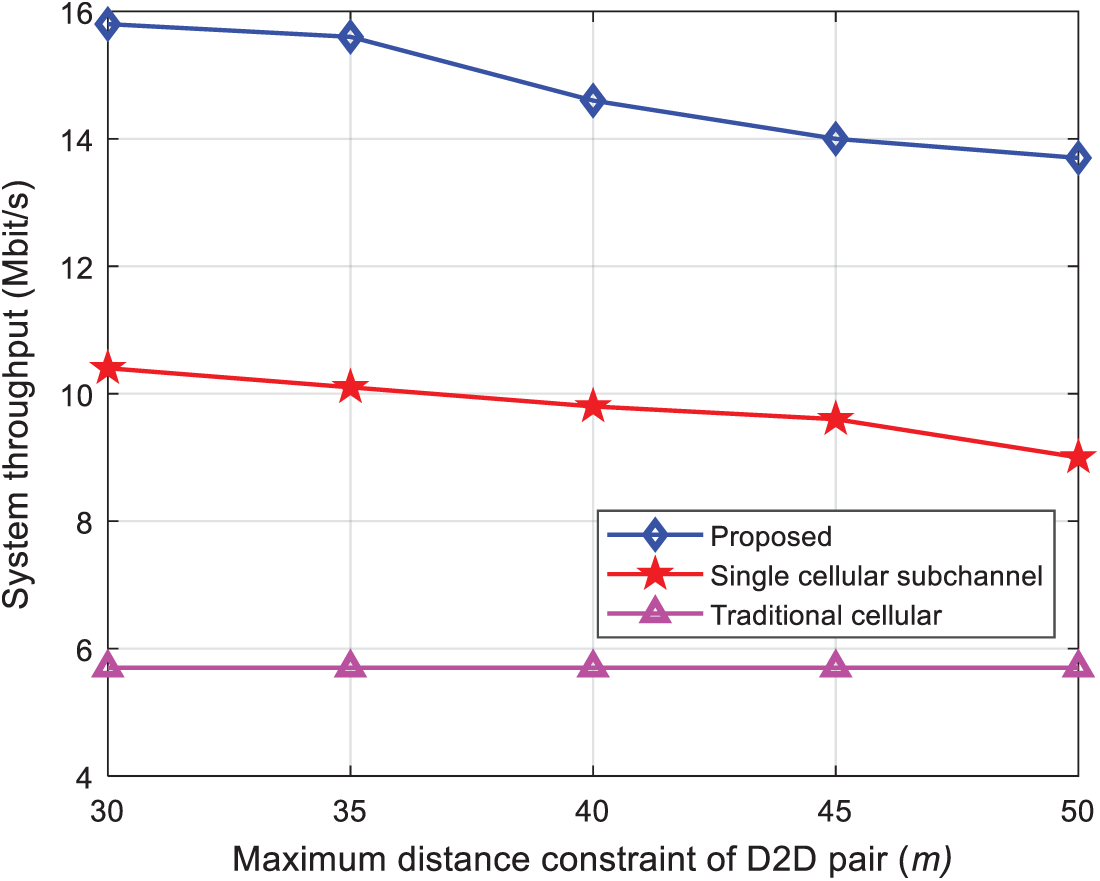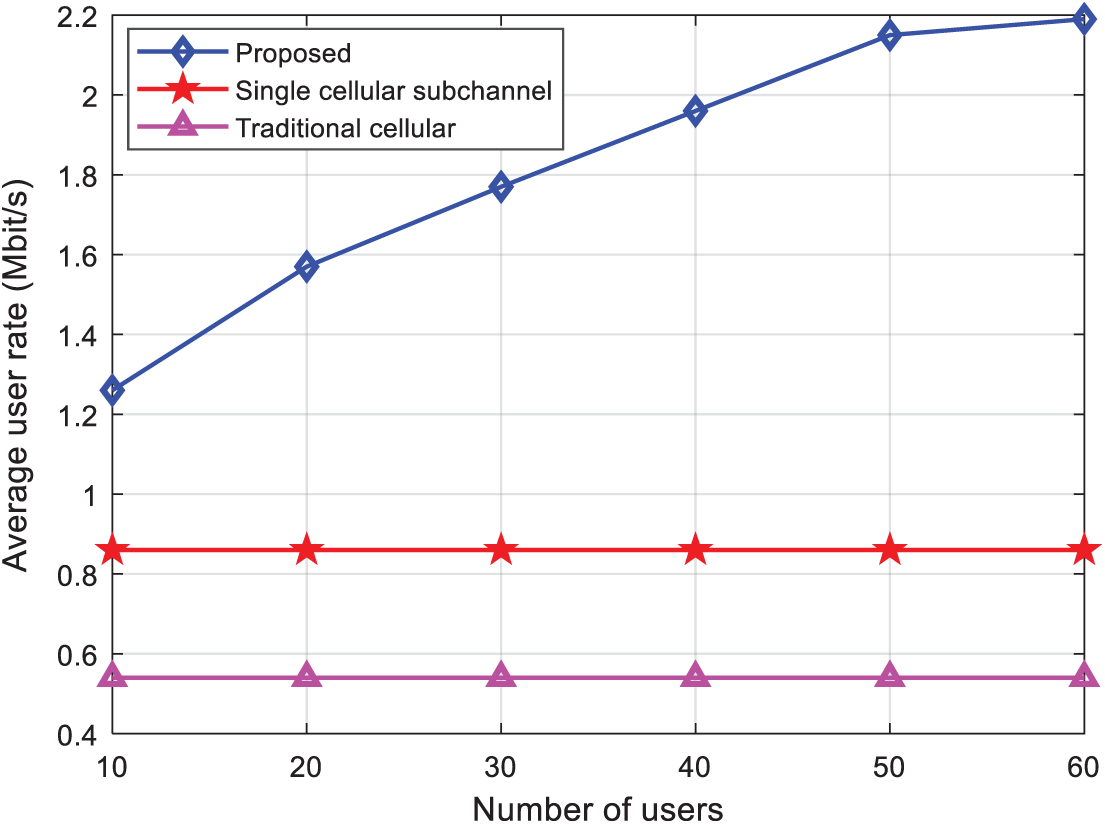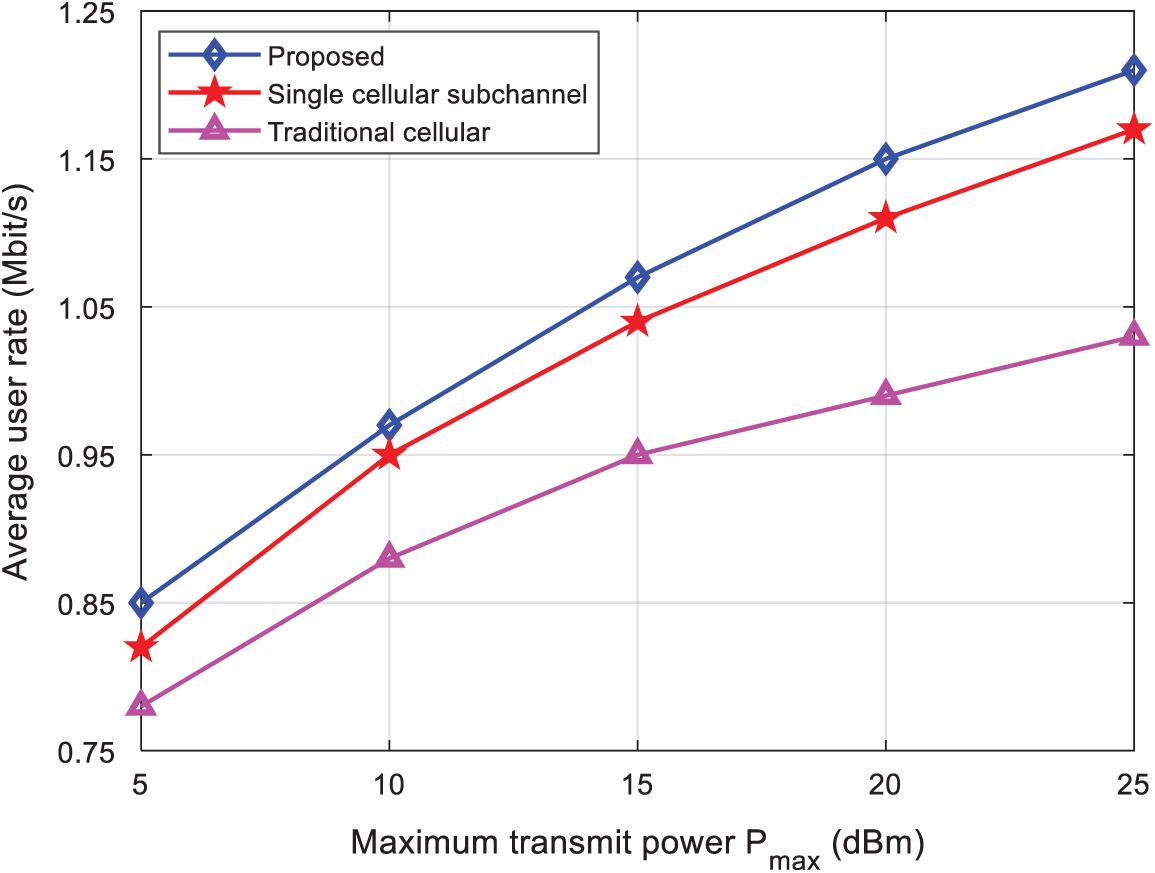DOI:10.32604/cmc.2022.020136

| Computers, Materials & Continua DOI:10.32604/cmc.2022.020136 |  |
| Article |
A Joint Resource Allocation Algorithm for D2D Communication
1Department of Electrical & Computer Engineering, University of Sharjah, Sharjah, United Arab Emirates
2Department of Electrical Engineering, College of Engineering, Princess Nourah bint Abdulrahman University, Saudi Arabia
3Department of Computer Science, King Khalid University, Muhayel Aseer, KSA & Faculty of Computer and IT, Sana’a University, Yemen
4Department of Electrical Engineering, University of Engineering and Technology Peshawar, Pakistan
5Department of Computer and Self Development, Preparatory Year Deanship, Prince Sattam bin Abdulaziz University, AlKharj, Saudi Arabia
*Corresponding Author: Fahd N. Al-Wesabi. Email: falwesabi@kku.edu.sa
Received: 11 May 2021; Accepted: 25 June 2021
Abstract: The emergence of multimedia services has meant a substantial increase in the number of devices in mobile networks and driving the demand for higher data transmission rates. The result is that, cellular networks must technically evolve to support such higher rates, to be equipped with greater capacity, and to increase the spectral and energy efficiency. Compared with 4G technology, the 5G networks are being designed to transmit up to 100 times more data volume with devices whose battery life is 10 times longer. Therefore, this new generation of networks has adopted a heterogeneous and ultra-dense architecture, where different technological advances are combined such as device-to-device (D2D) communication, which is one of the key elements of 5G networks. It has immediate applications such as the distribution of traffic load (data offloading), communications for emergency services, and the extension of cellular coverage, etc. In this communication model, two devices can communicate directly if they are close to each other without using a base station or a remote access point. Thus, eliminating the interference between the D2D and cellular communication in the network. The interference management has become a hot issue in current research. In order to address this problem, this paper proposes a joint resource allocation algorithm based on the idea of mode selection and resource assignment. Simulation results show that the proposed algorithm effectively improves the system performance and reduces the interference as compared with existing algorithms.
Keywords: D2D communication; resource allocation; wireless networks; mobile communication
In recent years, wireless local area networks (WLANs) have become quite popular due to their low cost of deployment and easy implementation, which enables the rapid proliferation of personal networks. But some unfavorable points should not be overlooked such as the operation in frequency bands where there is no interference control or guaranteed safety control [1–3]. These aspects motivate the inclusion of a new communication channel in mobile networks: Device-to-Device communication (D2D), which is currently under investigation to be included in the LTE-Advanced standard. The creation of IMT-Advanced promotes the application of new technologies that satisfy their requirements, from which the LTE-Advanced arises and begins to be standardized at the end of 2009 [4–9]. The LTE corresponds to the name of the commercial standard developed by the 3rd Generation Partnership Project (3GPP) for the evolution of UMTS mobile terrestrial radio access networks (e-UTRAN) standardized as of Release 8. D2D communication enables the establishment of a peer-to-peer communication mode between two LTE-A terminals, in such a way that there would be a better use of the LTE network resources and a higher throughput would be provided to the terminals in D2D communication [10].
In order to improve the performance of cellular networks and meet the user’s demand for speed, related technologies to improve the utilization of spectrum resources have become the research hotspots, such as cognitive radio and D2D communication technologies [11–14]. In traditional cellular networks, data is transmitted through base stations or other network elements. By using the D2D communication technology, when user terminals are relatively close, data can be directly transmitted. It cannot only increase the system throughput but also reduces the equipment power consumption and improves the system's spectrum utilization [15,16]. It also brings new challenges to wireless resource management, especially when D2D users reuses the cellular user resources, there is relatively serious co-channel interference. In order to reduce the co-channel interference, some interference management schemes have been proposed one after another [17–20]. Reference [21] proposes a power control scheme to ensure the SINR of the cellular link. Reference [22] proposes an optimal power allocation scheme in single-cell user and single D2D pair scenarios. Reference [23] proposes a game-based joint scheduling and resource allocation algorithm. Reference [24] proposes a resource allocation scheme based on interference perception. However, the above studies assumed that, the D2D pair reuses one cellular user resource. In fact, in downlink transmission, when the D2D pair is far from the eNB, the D2D pair can reuse one or more cellular user resources, thereby further improving the system throughput. When the D2D pair is close to the eNB, it suffers from greater interference and can use dedicated resources for communication.
This paper proposes a joint mode selection and resources allocation scheme based on the location of D2D users in the cell. In this method, the eNB first classifies the D2D pair according to the distance from the eNB. When the D2D pair is closer to the eNB, it is considered as a near-end D2D pair, and the eNB preferentially allocates the dedicated resources. When the D2D pair is far from the eNB, it is a remote D2D pair, and the eNB preferentially allocates the multiplexing resources. As the cycle progresses, the eNB will dynamically adjust the resource allocation for the D2D pair according to the resources and the terminal link rate, so that the D2D pair can be allocated appropriate resources. The simulation results show that the proposed scheme effectively reduces the interference between the users and improves the system throughput.
Assuming that the eNB in the macro cell is in the center of the cell, the cell contains two types of users, namely D2D and cellular users. D2D users exist in pairs, where each pair includes a transmitting and a receiving terminal. The D2D and cellular users are randomly distributed in the cell. The distance between the D2D transmitting and receiving terminals in the same D2D pair meets the maximum distance constraint, thereby ensuring the quality-of-service (QoS). Fig. 1 shows the scenario of downlink transmission. Assuming that, there is C number of cellular user equipment (CUE), K number of D2D pairs in the macro cell, and the position of the D2D pairs in the cell does not change.

Figure 1: Proposed system model
According to the distance between the eNB and receiving terminal of the D2D pair, the eNB divides the user pair into two types, namely the near-end D2D pair close to the eNB and the far-end D2D pair far away from the eNB. Assuming that, there are N orthogonal sub-channels (N > C) in the cell with bandwidth B, and n fixed sub-channels are allocated to the cellular users. Define a set of binary variables
The SINR of a D2D pair working in the dedicated mode is expressed as:
Among them,
The SINR of a D2D pair working in the multiplexing mode is expressed as
where,
The rate when the D2D user uses the sub-channel
The link transmission rate of D2D users to
The SINR of CUE can be expressed as
Among them,
The link rate of CUE
The total throughput of the system is expressed as:
In the downlink, the interference in the multiplexing mode mainly comes from the eNB and the D2D pair using the same sub-channel. Since the transmit power of the eNB is much greater than the transmit power of the D2D terminal, when the D2D pair and eNB are closer, then the interference is greater. At the same time, when the D2D pairs using the same sub-channel are closer, the interference between them is also greater. Therefore, the user pairs are classified according to the distance between the D2D pair and the eNB. When
In practice, the value of
This paper proposes a joint mode selection and resources allocation scheme based on the position of the D2D pair in the cell. The algorithm is divided into 3 stages, namely, the initial stage, dedicated resource allocation stage, and the multiplexed resource allocation stage. After the initial phase is completed, the dedicated resource allocation phase and the multiplexed resource allocation phase will be cycled. Through continuous cycles, the eNB will allocate appropriate resources to the D2D pair.
When the communication link of the D2D pair is established, the reference signal from the eNB is first received and compared with the threshold
If the D2D pair
During initialization, the near-end D2D pair works in a dedicated mode and uses the dedicated resources. The far-end D2D pair works in a multiplexing mode and reuses the cellular user resources. As the cycle progresses, the eNB dynamically allocate the resources to the D2D pair according to the resources and link rate.
3.2 Allocation of Dedicated Resources
In the dedicated resource allocation phase, the scheduler allocates the dedicated sub-channels in proper order. In the first dedicated resource allocation stage, the number of cycles
The priority function
Among them, the additional cost is expressed as
3.3 Allocation of Reused Resources
Reusing the D2D pairs in the set
Step 1: Confirm the multiplexed D2D pair set
Step 2: When the token is passed to the D2D pair
Step 3: Suppose that, when the D2D pair
Wherein,
When the D2D users multiplexes the cellular sub-channel
In the same way, the link rate of the CUE
where
If
then the D2D pair
Step 4: Assume that, the D2D user do not reuse the sub-channels of CUE
Assume that, the rate of the D2D pair
where,
In the same way, the link rate of the CUE
Among them,
If
then the D2D pair will uses the sub-channel
A link-level simulation program is established to test the scheme, and the simulation results are compared with the D2D scheme of multiplexing a cellular sub-channel and the pure cellular scheme.
4.1 Simulation Configuration and Parameters
Consider a single-cell scenario, where the cellular users and D2D pairs are randomly distributed in the cell. The distance between the terminals in a D2D pair meets the maximum distance constraint for communication. The received power
The system throughput simulation results of different schemes are shown in Fig. 2. When the channel quality of the direct link is good, the system throughput of the proposed algorithm and D2D pair multiplexing a cellular sub-channel scheme is greater than that of the pure cellular scheme. Although the D2D communication brings an increase in the total system throughput by reusing the cellular resources, the gain in the total system throughput decreases as the distance between the D2D pair and the terminal increases. When the maximum distance between the D2D pair is 50 m, the proposed scheme increases the performance by 41% as compared to the D2D pair multiplexing one cellular sub-channel scheme.


Figure 2: System throughput of different scenarios
Fig. 3 shows the simulation results of the average user rate of different scenarios. It can be seen from Fig. 3 that, the average user rate proposed scheme is higher than the single-cellular sub-channel and the traditional cellular schemes. As the number of D2D pairs increases, the average user rate has also been improved in the proposed scheme whereas the single-cellular sub-channel and traditional schemes shows fixed average user rate.

Figure 3: Average user rate of different schemes
The simulation results prove that the proposed scheme effectively reduces the interference between users and improves the system throughput.
Fig. 4 compared the average user rate of the algorithms vs. maximum transmit power. As can be seen from Fig. 4, the average user rate of all algorithms increases with increasing the transmit power. Moreover, the proposed algorithm gives a higher average user rate as compared with the existing algorithms. This shows that for all values of maximum transmit power, the proposed algorithm provides a better user rate and improves QoS.

Figure 4: Comparison of average user rate vs. transmit power
This paper analyzes the interference between the cellular users and D2D users and proposes a joint resource allocation scheme. In the solution, the eNB optimizes the communication mode and resource allocation of the D2D users according to their location in the cell and the terminal interference. The simulation results show that, compared with the traditional cellular scheme and the D2D-pair multiplexing single-cellular sub-channel scheme, the proposed scheme can better improve the total system throughput and terminal link rate, and reduces the interference between the users. Further research as an extension to this work is to consider the QoS and energy efficiency aspects and evaluate the performance.
Availability of Data and Material: The data used for the findings of this study is available upon request.
Funding Statement: The authors extend their appreciation to the Deanship of Scientific Research at King Khalid University for funding this work under Grant Number (RGP.2/23/42), https://www.kku.edu.sa. This research was funded by the Deanship of Scientific Research at Princess Nourah bint Abdulrahman University through the Fast-track Research Funding Program.
Conflicts of Interest: The authors declare that they have no conflicts of interest to report regarding the present study.
1. M. Waqas, Y. Niu, Y. Li, M. Ahmed, D. Jin et al., “A comprehensive survey on mobility-aware D2D communications: Principles, practice and challenges,” IEEE Communications Surveys & Tutorials, vol. 22, no. 3, pp. 1863–1886, 2020. [Google Scholar]
2. M. Ahmed, Y. Li, M. Waqas, M. Sheraz, D. Jin et al., “A survey on socially aware device-to-device communications,” IEEE Communications Surveys & Tutorials, vol. 20, no. 3, pp. 2169–2197, 2018. [Google Scholar]
3. F. S. Shaikh and R. Wismuller, “Routing in multi-hop cellular device-to-device (D2D) networks: A survey,” IEEE Communications Surveys & Tutorials, vol. 22, no. 3, pp. 2622–2657, 2018. [Google Scholar]
4. M. Haus, M. Waqas, A. Y. Ding, Y. Li, S. Tarkoma et al., “Security and privacy in device-to-device (D2D) communication: A review,” IEEE Communications Surveys & Tutorials, vol. 19, no. 2, pp. 1054–1079, 2017. [Google Scholar]
5. O. Hayat, R. Ngah, S. Z. M. Hashim, M. H. Dahri, R. F. Malik et al., “Device discovery in D2D communication: A survey,” IEEE Access, vol. 7, pp. 131114–131134, 2019. [Google Scholar]
6. A. Asadi, Q. Wang and V. Mancuso, “A survey on device-to-device communication in cellular networks,” IEEE Communications Surveys & Tutorials, vol. 16, no. 4, pp. 1801–1819, 2014. [Google Scholar]
7. B. M. Elhalawany, R. Ruby and K. Wu, “D2D communication for enabling internet-of-things: Outage probability,” IEEE Transactions on Vehicular Technology, vol. 68, no. 3, pp. 2332–2345, 2019. [Google Scholar]
8. I. Loannou, V. Vassiliou, C. Christophorou and A. Pitsillides, “Distributed artificial intelligence solution for D2D communication in 5G networks,” IEEE Systems Journal, vol. 14, no. 3, pp. 4232–4241, 2020. [Google Scholar]
9. P. Pawar, A. Trivedi and M. K. Mishra, “Outage and ASE analysis for power controlled D2D communication,” IEEE Systems Journal, vol. 14, no. 2, pp. 2269–2280, 2020. [Google Scholar]
10. S. Bashir, M. H. Alsharif, I. Khan, M. A. Albreem, A. Sali et al., “MIMO-Terahertz in 6G nano-communications: Channel modeling and analysis,” Computers, Materials & Continua, vol. 66, no. 1, pp. 263–274, 2020. [Google Scholar]
11. A. Amin, X. Liu, I. Khan, P. Uthansakul, M. Forsat et al., “A robust resource allocation scheme for device-to-device communications based on Q-learning,” Computers, Materials & Continua, vol. 65, no. 2, pp. 1487–1505, 2020. [Google Scholar]
12. S. Alemaishat, O. A. Saraereh, I. Khan, S. H. Affes, X. Li et al., “An efficient precoding scheme for millimeter-wave massive MIMO systems,” Electronics, vol. 8, no. 9, pp. 1–15, 2019. [Google Scholar]
13. A. Al-Nimrat, M. Smadi, O. A. Saraereh and I. Khan, “An efficient channel estimation scheme for mmwave massive MIMO systems,” in Proc. IEEE Int. Conf. on Communication, Networks and Satellite, Makassar, Indonesia, pp. 1–8, 2019. [Google Scholar]
14. I. Khan and D. Singh, “Efficient compressive sensing based sparse channel estimation for 5G massive MIMO systems,” AEU-International Journal of Electronics and Communications, vol. 89, no. 2, pp. 181–190, 2018. [Google Scholar]
15. A. Amin, X. H. Liu, M. A. Saleem, S. Henna, T. Islam et al., “Collaborative wireless power transfer in wireless rechargeable sensor networks,” Wireless Communications and Mobile Computing, vol. 15, pp. 1–13, 2020. [Google Scholar]
16. F. Jameel, T. Ristaniemi, I. Khan and B. M. Lee, “Simultaneous harvest-and-transmit ambient backscatter communications under Rayleigh fading,” EURASIP Journal on Wireless Communications and Networking, vol. 19, no. 1, pp. 1–9, 2019. [Google Scholar]
17. W. Shahjehan, S. Bashir, S. L. Mohammed, A. B. Fakhri, A. A. Isaiah et al., “Efficient modulation scheme for intermediate relay-aided IoT networks,” Applied Sciences, vol. 10, no. 6, pp. 1–12, 2020. [Google Scholar]
18. O. A. Saraereh, A. Alsaraira, I. Khan and B. J. Choi, “A hybrid energy harvesting design for on-body internet-of-things (IoT) networks,” Sensors, vol. 20, no. 2, pp. 1–14, 2020. [Google Scholar]
19. T. Jabeen, Z. Ali, W. U. Khan, F. Jameel, I. Khan et al., “Joint power allocation and link selection for multi-carrier buffer aided relay network,” Electronics, vol. 8, no. 6, pp. 1–15, 2019. [Google Scholar]
20. S. Alemaishat, O. A. Saraereh, I. Khan and B. J. Choi, “An efficient resource allocation algorithm for D2D communications based on noma,” IEEE Access, vol. 7, pp. 120238–120247, 2019. [Google Scholar]
21. C. H. Yu, O. Tikkonen, K. Doppler and C. Ribeiro, “On the performance of device-to-device underlay communication with simple power control,” in IEEE Vehicular Technology Conf., Barcelona, Spain, pp. 1–5, 2009. [Google Scholar]
22. C. H. Yu, O. Tirkkonen, K. Doppler and C. Rebeiro, “Power optimization of device-to-device communication underlaying cellular communication,” in IEEE Int. Conf. on Communications, Dresden, Germany, pp. 1–5, 2009. [Google Scholar]
23. F. R. Wang, L. Y. Song, Z. Han, Q. Zhao and X. Wang, “Joint scheduling and resource allocation for device-to-device underlay communication,” in IEEE Wireless Communications and Networking Conf., Shanghai, China, pp. 134–139, 2013. [Google Scholar]
24. P. Janis, V. Koivunen, C. Ribeiro, J. Korhonen, K. Doppler et al., “Interference-aware resource allocation for device-to-device radio underlaying cellular networks,” in IEEE Vehicular Technology Conf., Barcelona, Spain, pp. 1–5, 2009. [Google Scholar]
25. S. Wen, X. Y. Zhu, X. Zhang and D. Yang, “QoS-aware mode selection and resource allocation scheme for device-to-device (D2D) communication in cellular networks,” in IEEE Int. Conf. on Communications, Budapest, pp. 101–105, 2013. [Google Scholar]
 | This work is licensed under a Creative Commons Attribution 4.0 International License, which permits unrestricted use, distribution, and reproduction in any medium, provided the original work is properly cited. |